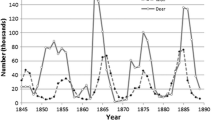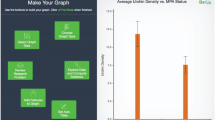Abstract
Science communication, as a hybrid, involves the concomitant reading of graphical representations and natural language. A scientifically literate individual should be able to make sense of both sites of information in relation to one another. In this paper, we explore the ability of 61 students from a highly rated, all-girls Catholic School to make sense of inconsistent graphical and textual data and examine their interpretations within 3 distinct settings: individually on a paper assessment, in a one-to-one interview with the researchers, and through classroom conversation. This study indicates that (1) sense-making was difficult for even advanced students and (2) different interpretations of text evolved within each of the 3 settings. Many students initially privileged natural language over the data represented on the graph and sought ways to explain how the incorrect description could somehow be construed as accurate. Although these students could successfully complete school assignments related to graphs, their skills in reading authentic, real-world science communication was limited. We recommend that teachers invite discussion of various semiotic forms rather than scaffold for correctness. Students have learned to do schoolwork, but they are much less able to engage critically in real-world science.



Similar content being viewed by others
References
Berg, C. A. & Phillips, D. G. (1994). An investigation of the relationship between logical thinking structures and the ability to construct and interpret line graphs. Journal of Research in Science Teaching, 31, 323–344.
Berg, C. A. & Smith, P. (1994). Assessing students’ abilities to construct and interpret line graphs: Disparities between multiple-choice and free-response instruments. Science Education, 78(6), 527–554.
Bowen, G. M. & Roth, W.-M. (2002). Why students may not learn to interpret scientific inscriptions. Research in Science Education, 32, 303–327.
Bybee, R. W. (1997). Achieving scientific literacy: From purposes to practices. Portsmouth, NH: Heinemann.
DeBoer, G. E. (2000). Scientific literacy: Another look at its historical and contemporary meanings and its relationship to science education reform. Journal of Research in Science Teaching, 37(6), 582–601.
Farrar, C. (2012). Assessing the impact participation in science journalism activities has on scientific literacy among high school students. (Doctoral dissertation). Retrieved from https://apps.umsl.edu/webapps/weboffice/ETD/query.cfm?id=r7382.
Friel, S. N., Curcio, F. R. & Bright, G. W. (2001). Making sense of graphs: Critical factors influencing comprehension and instructional implications. Journal for Research in Mathematics Education, 32(2), 124–158.
Kohnen, A. (2013). The authenticity spectrum: The case of a science journalism writing project. English Journal, 102(5), 28–34.
Kress, G. (1997). Before writing: Rethinking the paths to literacy. London, England: Routeledge.
Leinhardt, G., Zaslavsky, O. & Stein, M. K. (1990). Functions, graphs, and graphing: Tasks, learning, and teaching. Review of Educational Research, 60, 1–64.
Lemke, J. (1998). Multiplying meaning: Visual and verbal semiotics in scientific text. In J. R. Martin & R. Veel (Eds.), Reading science: Critical and functional perspectives on discourses of science (pp. 87–113). London, England: Routeledge.
Lemke, J. (2004). The literacies of science. In E.W. Saul (Ed.), Crossing borders in literacy and science instruction: Perspectives on theory and practice (pp. 33-47). Arlington, VA: NSTA press.
National Research Council (2012). A framework for K-12 science education: Practices, crosscutting concepts, and core ideas. Washington, DC: The National Academies Press. Retrieved from http://www.nap.edu/openbook.php?record_id=13165.
Polman, J. L., Newman, A., Saul, E. W. & Farrar, C. (2014). Adapting practices of science journalism to foster science literacy. Science Education, 98(5), 766–791.
Preece, J. & Janvier, C. (1993). Interpreting trends in multiple-curve graphs of ecological situations: The role of context. International Journal of Science Education, 15, 199–212.
Roth, W.-M. (2002). Reading graphs: Contributions to an integrative concept of literacy. Journal of Curriculum Studies, 34(1), 1–24.
Roth, W.-M. & Bowen, M. G. (1998). Lecturing graphing: What features of lectures contribute to student difficulties in learning to interpret graphs. Research in Science Education, 28(1), 77–90.
Roth, W.-M. & Bowen, M. G. (2000). Learning difficulties related to graphing: A hermeneutic phenomenological perspective. Research in Science Education, 30(1), 123–139.
Roth, W.-M. & Lee, Y. J. (2004). Interpreting unfamiliar graphs: A generative, activity theoretic model. Educational Studies in Mathematics, 57(2), 265–290.
Roth, W.-M. & McGinn, M. K. (1997). Graphing: Cognitive ability or practice? Science Education, 81, 91–106.
Roth, W.-M., Bowen, M. G. & McGinn, M. K. (1999). Interpretations of graphs by university biology students and practicing scientists: Toward a social practice view of scientific representation practices. Journal of Research in Science Teaching, 36(9), 1020–1043.
Saul, E. W., Kohnen, A., Newman, A., & Pearce, L. (2012). Front page science: Engaging teens in science literacy. Arlington, TX: NSTA Press.
Schönborn, K. J. & Anderson, T. R. (2006). The importance of visual literacy in the education of biochemists. Biochemistry and Molecular Biology Education, 34(2), 94–102.
Schönborn, K. J. & Anderson, T. R. (2008). A model of factors determining students’ ability to interpret external representations in biochemistry. International Journal of Science Education, 31, 193–232.
Shah, P. & Carpenter, P. A. (1995). Conceptual limitations in comprehending line graphs. Journal of Experimental Psychology, 124(1), 43.
Shah, P., Mayer, R. E. & Hegarty, M. (1999). Graphs as aids to knowledge construction: Signaling techniques for guiding the process of graph comprehension. Journal of Educational Psychology, 91(4), 690–702.
Wainer, H. (1992). Understanding graphs and tables. Educational Researcher, 21, 12–23.
Acknowledgments
This material is based upon work supported by the National Science Foundation under Grant No. DRL-0822354. All statements are the responsibility of the authors.
Author information
Authors and Affiliations
Corresponding author
Rights and permissions
About this article
Cite this article
Whitacre, M.P., Saul, E.W. High School Girls’ Interpretations of Science Graphs: Exploring Complex Visual and Natural Language Hybrid Text. Int J of Sci and Math Educ 14, 1387–1406 (2016). https://doi.org/10.1007/s10763-015-9677-7
Received:
Accepted:
Published:
Issue Date:
DOI: https://doi.org/10.1007/s10763-015-9677-7




